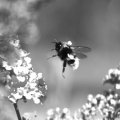The University of Queensland's robotic rodent became the mouse that roared in the international APEC Micromouse Championship held in the United States in March.
Gordon Wyeth, a PhD student and lecturer in the Electrical and Computer Engineering Department, beat robot designers from around the world with his mouse design, Cuqee III.
Cuqee III and its predecessors Cuqee II and Cuqee won the national robotic mouse championship, Ozmouse, in 1988, 1990 and from 1993-96.
Despite Cuqee III's success, Mr Wyeth is already working on the fourth generation to compete in this year's national championship in November.
The Atlanta competition required national finalists from the USA, UK, Japan, Korea and Australia each to build a robotic mouse that could navigate the fastest way to the centre of a maze. Each entry had 10 minutes to determine the fastest path, providing time for the mouse to store information on each navigation, and so increase its speed.
Mr Wyeth's 260g micromouse found its way to the maze's centre in 22 seconds. The next best competitor took 34 seconds.
Mr Wyeth said Cuqee III's main components included infra-red sensors, motor, batteries and computer to control decision-making and store information.
'The micro-processor's ability to make decisions about how fast and slow the mouse goes gives it the competitive edge,' he said. 'The secret is to design a mouse with a lower centre of gravity, to shrink every part like a grand prix car, so each generation has become smaller.'
It was the first time in the competition's 12-year history that a competitor outside the USA or Japan won first prize of US$150. Mr Wyeth also received US$1500 towards travel expenses.
'The competition advances mobile robot technology and provides an opportunity for competitors to exchange information,' he said.
Mr Wyeth has been involved with the the project from its conception in 1988 when he was a fourth-year engineering undergraduate.
Although the components cost only $600, numerous Department academics and students had spent over hundreds of hours developing the mouse's software and design, he said.
'It's always been a side interest to the central theme of my work,' Mr Wyeth said. 'It's fun and a hobby.'
Mr Wyeth's 'hobby' has become a valuable teaching tool as a case study in a fourth-level robotics subject at the University.
'It demonstrates to students techniques used by engineers in real world products and promotes research in areas of navigation and intelligence.'
For more information, contact Mr Wyeth (telephone 07 3365 3770).



